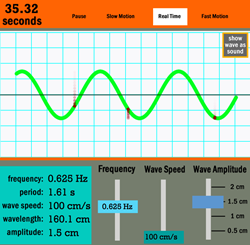 Simple Wave Simulator
Simple Wave Simulator
Resource:
Physics Interactives: Simple Wave Simulator
Grade Level: High School
Description:
This interactive simulation provides a versatile set of tools for exploring properties of a simple wave. Students can view the wave as a rope (transverse) or as sound (longitudinal), and can also change frequency, amplitude, and wave speed. As the simulation runs, it automatically generates the values of wave speed, frequency, amplitude, wavelength, and period. Teachers can introduce it at just about any phase of a unit on wave properties.
Performance Expectation:
HS-PS4-1 Use mathematical representations to support a claim regarding relationships among the frequency, wavelength, and speed of waves traveling in various media.
This activity aligns with the three dimensions of the Next Generation Science Standards in the manner described below:
| Wave Properties (HS-PS4.A.1): The wavelength and frequency of a wave are related to one another by the speed of travel of the wave, which depends on the type of wave and the medium through which it is passing. |
The Wave Simulator specifically models what happens to a wave pattern when frequency or amplitude is changed. Further, it automatically generates values for both wavelength and wave speed, allowing the learner to see the relationship between these two components. |
| Patterns: Different patterns may be observed at each of the scales at which a system is studied and can provide evidence for causality in explanations of phenomena. |
This simulation offers a way to introduce students to the patterns of periodic motion that occur in simple waves. It helps students visualize the various components of a wave, including amplitude, frequency, and wavelength. Changing any of these components affects the wave pattern, which is shown very clearly in the simulation. |
| Structure and Function: The function of natural and designed objects and systems can be inferred from their overall structure, the way their components are shaped and used, and the molecular substructures of its various materials. |
Wave structure is specifically addressed by this simulation in the following ways: 1) As students change the values of amplitude, frequency, and wave speed, they can see how the overall structure of the wave is affected by each component; 2) The simulation displays three red “particles” located along the medium that represent the molecular structure and allow students to see how particles behave as the wave disturbance travels. The latter will help students differentiate particle motion from wave motion (the particles vibrate about a fixed position while the wave itself travels from one end of the medium to the other). |
| Developing and Using Models: Use a model to predict the relationships between systems or between components of a system. |
The Wave Simulator lets students explore how wave speed, amplitude, and frequency are related in both a transverse and longitudinal wave. As the simulation runs, it automatically generates the values of wave speed, frequency, amplitude, wavelength, and period. Students can toggle from slow motion, real time, and fast motion to help them visualize how the various components of a simple wave can be used to predict its behavior. |
Associated Reading from The Physics Classroom
Other Supporting Pages at The Physics Classroom:
View Infographic.
(Coming Soon)
Search the NGSS Corner
Maybe you're looking for something really specific that pertains to a desired topic and emphasizes one or more of the listed NGSS dimensions. Why not try a search of this section of our website? Simply select from one or more of the pull-down menus and click Search This page will reload and a collection of possibilities will be displayed in this section of the page and sorted by relevancy.